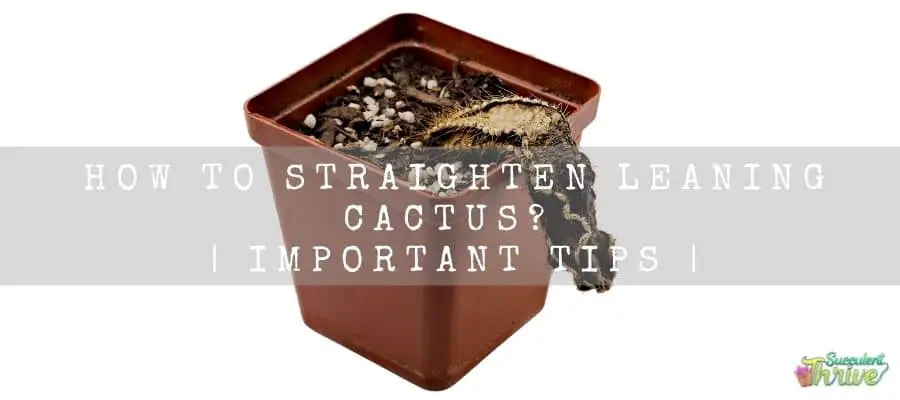How to straighten leaning cactus is a problem among most cactus gardeners. There are several reasons for this common problem. In this article I am going to describe reasons and solutions for this problem.
First let’s find out the reasons.

Why is my cactus leaning to one side?
Your cactus may lean towards one side due to several reasons. Out of that, the lapses in sunlight is one reason for this condition. Cactus have strong requirements when it comes to sunlight unlike the rest of other plants. If they cannot fulfill this requirement, they would tend to lean towards the best possible sunlight source they can reach.
Consequently, they would become misshapen in appearance. Eventually, it would ruin the pleasant look they have. When it gets severe, it would even kill the plants.
However, cacti usually form in different shapes as well as in different sizes. For example, there are cactus such as golden spiked barrels which usually form in huge balls on the ground. On the other hand, cacti such as saguaro cacti would form in an upward manner. So, if you have a tall cactus which has a shallow root system, chances are that they would tend to lean towards one side.
Hence, if you are a cacti gardener and going through these conditions, it is important that you know how to straighten a cactus properly. To do that, ensure that you apply the correct techniques so that the plants can grow healthily.
We are going to cover the facts which could make the cactus lean and on the modes of rectifying them.
It is somewhat difficult to handle the cacti as they may carry spines and chances are that they may hurt you as well. Hence, I recommend wearing gloves when you are interacting with the plants.
Diseases
Your cactus may lean due to root rot. Fungal infections and bacteria are what could cause this condition. Further, the root causes for fungal and bacteria is over watering. Once you provide excess water, it would lead the plant to drooling.
If you wish to ascertain whether root rot has caused the plants to lean, you need to first inspect the infected place.
If you feel like it is mushy and soft, it is probably due to root rot. Once you figure that out, you need to treat them faster. If you fail to treat them, chances are that you may even lose your precious cactus. As such, it is best to take the plants out of the older pots and treat the infected spots with a fungicide. At last, you can consider transplanting them.
Pest
There are pests such as mealybugs, ants, and other types of pests that could cause the cactus to lean. If I elaborate on the pests, they will suck the sap from the cactus plant parts, be it the stems or the leaves. Consequently, it will make them look unhealthy and misshapen. Moreover, it would make the cactus more vulnerable to other fungal infections too.
Ultimately, it would kill the plants. You can ascertain that pests have caused the cactus to lean if you spot any pests hanging around the plants. Once you emphasize that pests have caused the cactus to lean, you need to proceed with an effective pest extermination mode to overcome that.
Light condition
Cacti are usually adapted to grow in bright, lit, warm places in their native places. They can stand the high heat as well as the intense sunlight. Having said that, indoor-grown cacti cannot stand the high heat for extended periods. However, they still need to have adequate sunlight so that they can grow straight and vigorously.
Unless it causes the plants to droop and lean toward the brightest light they can get. If you spot a lean in your cactus and if you cannot spot any pests hanging around your plants or any symptoms of any diseases, it could be mainly due to a lack of sunlight exposure.
Temperatures
Freezing damage could cause cactus drooping as well. If you notice any blackened exposed parts, it means the frost damage is in its early stages. It would get worse and make the plants wilt after a few weeks.
Having said that, many cacti suffer from winter stress. Once the temperature increases, it slowly gets back to normal. However, it is important that you act wisely and try to avoid frost damage as much as you can. You can either use radiated heat or microwave them to accomplish this. Besides, you may also cover them with cotton sheets during the winter.
Soil and pot
Usually, when you are growing cacti, you need to select containers that are not too big. If you do so, it will be difficult for the roots to absorb sufficient nutrients and water. On the other hand, if you have grown them in too small pots, roots cannot spread freely, and instead they will tend to grow compact while striving for more space.
Ideally, you need to select pots that are about 1 or 2 inches larger than the plants. further ensure that you repotted them periodically too. It could be once every two years. In addition to the pot, if the chosen soil mix does not provide sufficient stability, it will make one side of the plant lean in a certain direction. Ideally, you need to always wait until the soil dries before you water them again. Always try to keep dry soil available for them.
Watering
Over watering and under watering can also result in the plants drooping. Ideally you need to water cactus once or twice a month during summer and in spring. On the other hand, you can just water them once a month during winter. If under watering has caused the plants to lean, you could spot the weak stems which have drooped. Further their regular colors would also change.
Keep in mind that you need to water them once a month during winter as they need to transpire in cooler conditions. If you had supplied excess water for the cactus, there would be a great potential for the root rot to take place. As such it is critical that you grow them in a fast-draining soil mix and in a pot which has an ample draining as well.
How to straighten leaning cactus
Straightening a leaning cactus is quite easy when you identify as to what exactly caused the plants for leaning.
01. Watering
Keep in mind that you should always water your cactus only if their first top layer is dry. You need to water the plants only if you are sure that they are dry. To do that, you can simply place your finger in the soil and check.
On the other hand, if it is moist, you should wait until it gets dry and then resume watering the plants. If it continues to be soggy for a prolonged period, you need to change the soil medium to a fast-draining one. If the soil keeps retaining water for too long, it will cause the plants to lean. Additionally, you should always select a pot that is well-draining.
02. Pest control
If you figure out that pests such as mealybugs or any other ants have caused the leaning of the cactus, you can pick them up by hand and kill them. Having said that, you may also use insecticidal soap and kill both the adults and the hatched eggs. You can also rinse them off the plants. You may use a concentrated liquid dish soap for this purpose. This would be quite productive, especially if the bugs have spread on a minor level and if they have not resulted in the drooping of the cactus.
03. Repotting
I recommend repotting once every two years, as that will provide adequate space for the cactus roots to grow. Moreover, it would allow you to have a close inspection of the plant’s roots, and if there are any rotten parts, you may get rid of them at this point.
04. Light condition
As aforesaid, cacti have strong requirements when it comes to light. In their native habitats, they would grow in bright sunlight. Hence, when you grow them as garden plants or as indoor plants , you need to ensure that you mimic the same conditions as they get in their natural habitats there also. That would be the most effective way to treat the plants’ leaning.
Literally, if you have grown them with less exposure to sunlight, you need to expose them to more sunlight. Not only that, but you can also move your plants outdoors to supplement them with extra sunlight. You may keep them either on your patio or on the terrace. When they start to grow upright, you may bring them indoors.
05. Temperature
Cactus prefer to stay in heat, as aforesaid. Hence, you need to protect the plants from frost during the winter. The hibernation of the cacti takes place during the winter. As a result, it is best to place them in radiated heat at night. Alternatively, you may cover them with frosty clothes as well.
How to stake a cactus?
If you want to stake an immature cactus, you must first dig a hole directly opposite the direction it is leaning. However, when you dig the hole, ensure that you do not harm the cactus roots. You need to push a stake that is about 6 feet long into the hole. Next, fill the soil back into the hole while using a shovel. Ideally, you need to bury about one-half of the stake. so that it would not stay stable in the soil medium. I recommend using a sturdy material for the stake.
For example, you could use hardwood, bamboo, or other materials to hold the cactus straight up. Once you complete this step, you need to wrap the stake and the cactus with green horticultural tape. I recommend wearing protective gloves throughout the process so that the cactus spines may not harm you.
Do not tie a tight knot in the tape and instead, you need to tie, place a loose knot, and cut off the loose ends whilst using a pair of scissors. If you end up tying the loose ends tightly, it will harm the outer surface. Ultimately, it would be attractive for the pests and for other disease types.
Why cactus leaning towards sun
When a cactus is stressed, it may lean toward the sun. Cacti are usually hardy versatile plants which do not require much maintenance from you. Having said that, it is important that you still fulfill the required growth necessities and if not, your plants may struggle to grow upright and instead they would lean. You can spot this condition in both indoor plants and in outdoor plants. In that circumstance it is important that you closely inspect your plant and see what exactly has caused the plant to lean.
It is always best to detect these problems so that you can treat them well. Cacti used to grow in locations where they can gain bright sunlight. Hence if the cacti grow deprived of sufficient sunlight, it will make them lean towards the best possible sunlight they can reach. That means the plants require more sunlight exposure. In addition to that, diseases, watering, transplant shock could also result in the cactus leaning.
Final Thoughts
To wind up , if you can closely monitor your cactus and see exactly what has caused the plants to lean and take the necessary actions, you can revive the plants without letting them go through any stress. That will allow the cactus to grow healthily and vigorously. Cacti are easy-care plants, and if you ensure that you look after them well and provide the right growing care tips, your cactus may grow healthily and flourish.
Read Next : Spot On Cactus | What Should I Do ?


